Abstract
Variation in the chromosomal genomes of 1527 isolates of eight common serotypes (O and H antigen profiles) of Salmonella was assessed by analysis of electrophoretically demonstrable allelic polymorphism at 23 metabolic enzyme loci. Seventy-one distinctive electrophoretic types, representing multilocus genotypes, were identified. A basically clonal population structure was indicated by the presence of strong linkage disequilibrium among enzyme loci, the association of each serotype with a relatively small number of multilocus enzyme genotypes, and the global distribution of certain genotypes. For each of six of the serotypes, 83-96% of isolates were members of a single clone. The occurrence of each of four serotypes (S. derby, S. enteritidis, S. infantis, and S. newport) in isolates of clones belonging to several evolutionary lineages, some of which are distantly related, suggests that the horizontal transfer and recombination of chromosomal genes mediating expression of cell-surface antigens has been a significant process in the evolution of the salmonellae. Two divergent clone clusters of S. derby differ in the relative frequency with which they cause disease in birds versus mammals, and two major lineages of S. newport differ in the frequency with which their clones are associated with disease in humans versus animals.
Full text
PDF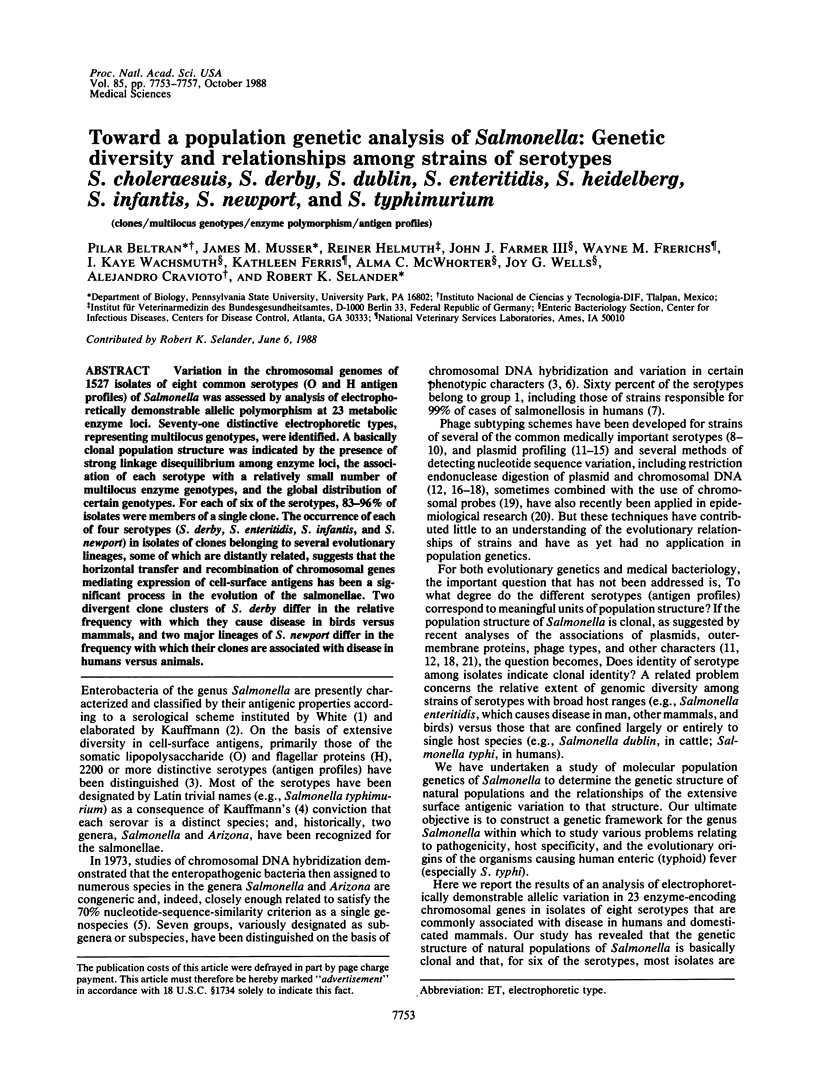
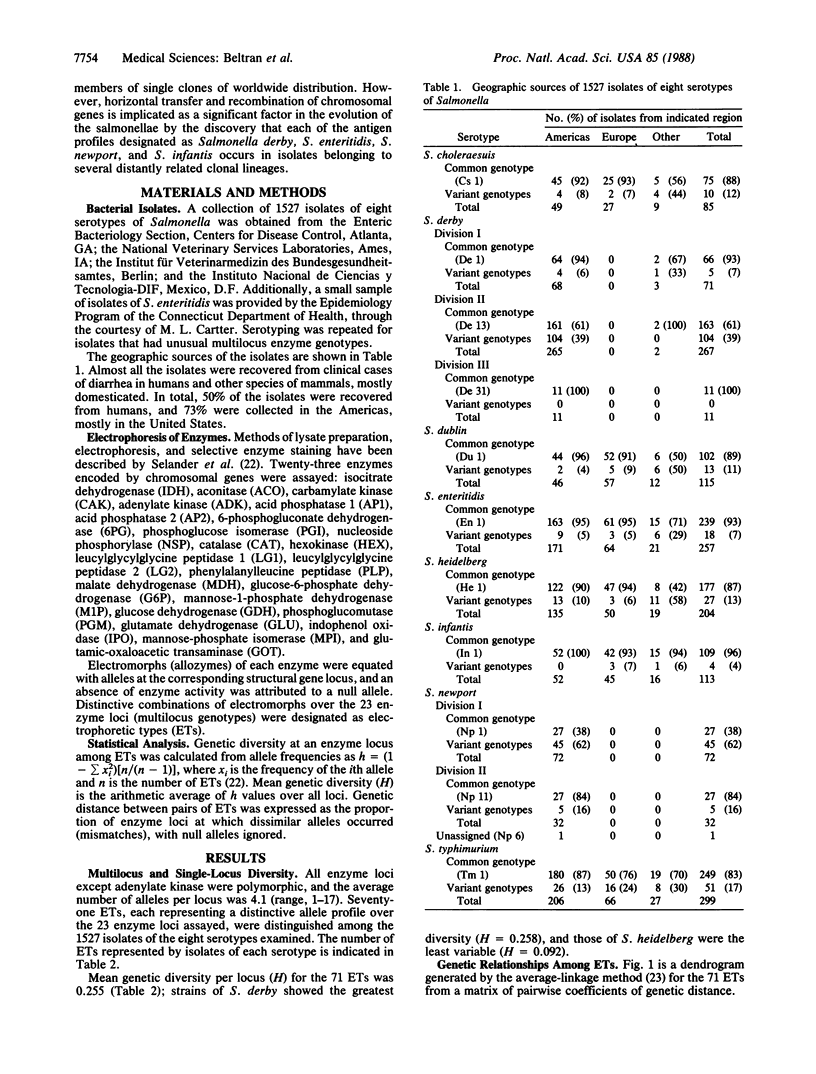
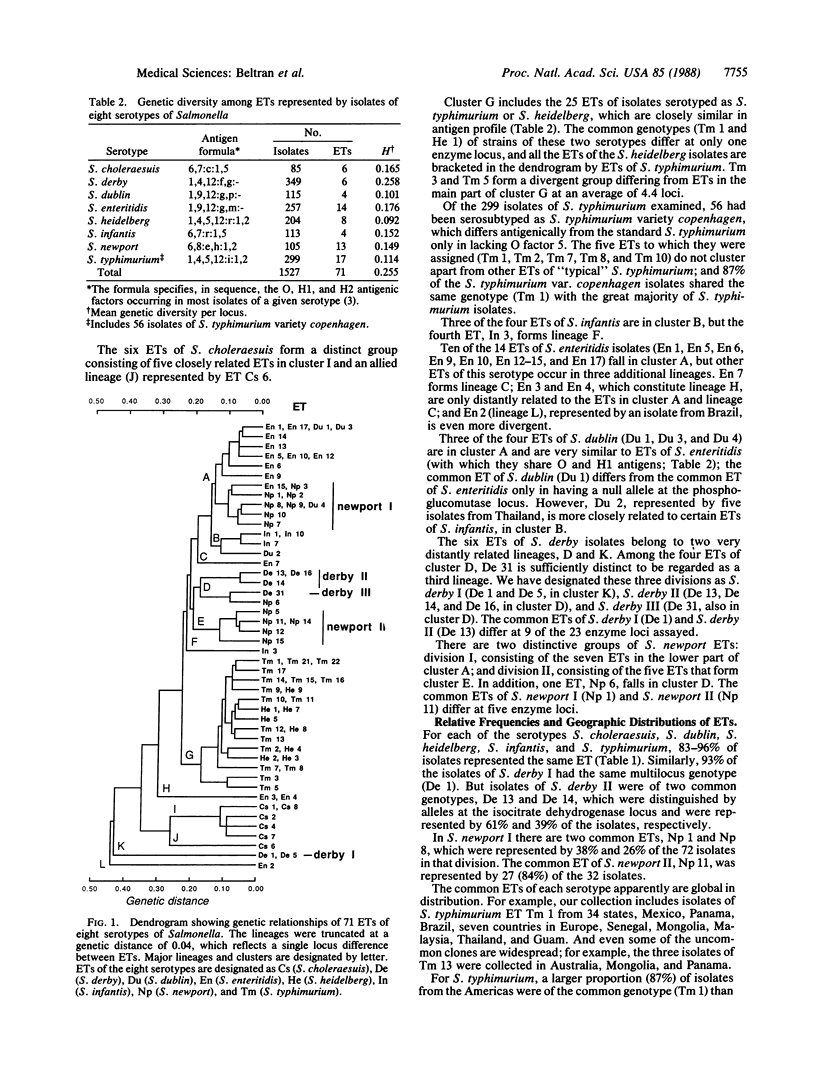
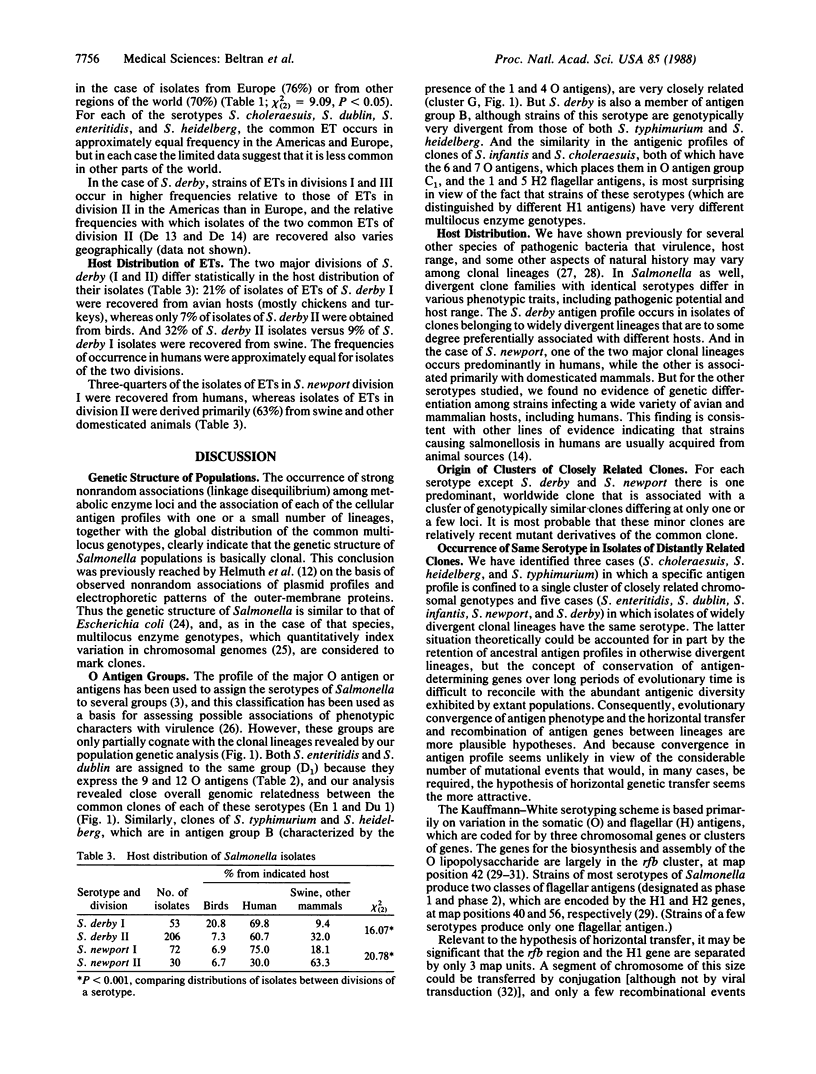
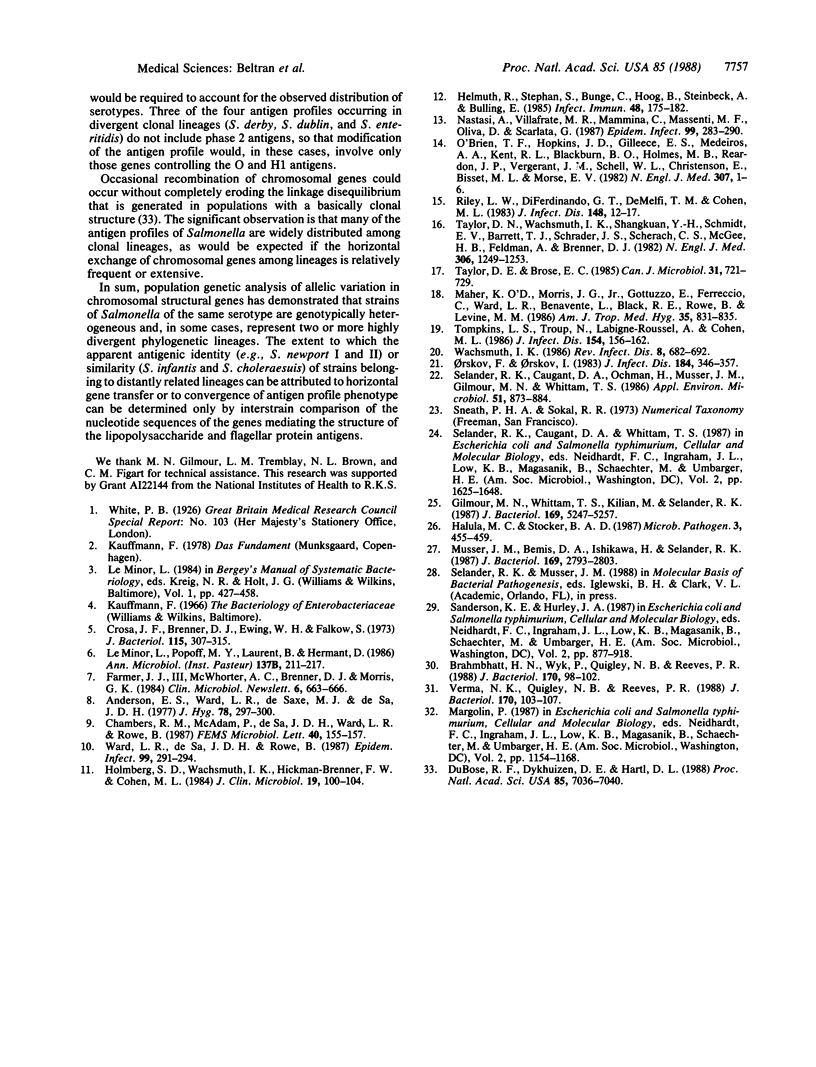
Selected References
These references are in PubMed. This may not be the complete list of references from this article.
- Anderson E. S., Ward L. R., Saxe M. J., de Sa J. D. Bacteriophage-typing designations of Salmonella typhimurium. J Hyg (Lond) 1977 Apr;78(2):297–300. doi: 10.1017/s0022172400056187. [DOI] [PMC free article] [PubMed] [Google Scholar]
- Brahmbhatt H. N., Wyk P., Quigley N. B., Reeves P. R. Complete physical map of the rfb gene cluster encoding biosynthetic enzymes for the O antigen of Salmonella typhimurium LT2. J Bacteriol. 1988 Jan;170(1):98–102. doi: 10.1128/jb.170.1.98-102.1988. [DOI] [PMC free article] [PubMed] [Google Scholar]
- Crosa J. H., Brenner D. J., Ewing W. H., Falkow S. Molecular relationships among the Salmonelleae. J Bacteriol. 1973 Jul;115(1):307–315. doi: 10.1128/jb.115.1.307-315.1973. [DOI] [PMC free article] [PubMed] [Google Scholar]
- DuBose R. F., Dykhuizen D. E., Hartl D. L. Genetic exchange among natural isolates of bacteria: recombination within the phoA gene of Escherichia coli. Proc Natl Acad Sci U S A. 1988 Sep;85(18):7036–7040. doi: 10.1073/pnas.85.18.7036. [DOI] [PMC free article] [PubMed] [Google Scholar]
- Gilmour M. N., Whittam T. S., Kilian M., Selander R. K. Genetic relationships among the oral streptococci. J Bacteriol. 1987 Nov;169(11):5247–5257. doi: 10.1128/jb.169.11.5247-5257.1987. [DOI] [PMC free article] [PubMed] [Google Scholar]
- Halula M. C., Stocker B. A. Distribution and properties of the mannose-resistant hemagglutinin produced by Salmonella species. Microb Pathog. 1987 Dec;3(6):455–459. doi: 10.1016/0882-4010(87)90015-5. [DOI] [PubMed] [Google Scholar]
- Helmuth R., Stephan R., Bunge C., Hoog B., Steinbeck A., Bulling E. Epidemiology of virulence-associated plasmids and outer membrane protein patterns within seven common Salmonella serotypes. Infect Immun. 1985 Apr;48(1):175–182. doi: 10.1128/iai.48.1.175-182.1985. [DOI] [PMC free article] [PubMed] [Google Scholar]
- Holmberg S. D., Wachsmuth I. K., Hickman-Brenner F. W., Cohen M. L. Comparison of plasmid profile analysis, phage typing, and antimicrobial susceptibility testing in characterizing Salmonella typhimurium isolates from outbreaks. J Clin Microbiol. 1984 Feb;19(2):100–104. doi: 10.1128/jcm.19.2.100-104.1984. [DOI] [PMC free article] [PubMed] [Google Scholar]
- Le Minor L., Popoff M. Y., Laurent B., Hermant D. Individualisation d'une septième sous-espèce de Salmonella: S. choleraesuis subsp. indica subsp. nov. Ann Inst Pasteur Microbiol. 1986 Sep-Oct;137B(2):211–217. [PubMed] [Google Scholar]
- Maher K. O., Morris J. G., Jr, Gotuzzo E., Ferreccio C., Ward L. R., Benavente L., Black R. E., Rowe B., Levine M. M. Molecular techniques in the study of Salmonella typhi in epidemiologic studies in endemic areas: comparison with Vi phage typing. Am J Trop Med Hyg. 1986 Jul;35(4):831–835. doi: 10.4269/ajtmh.1986.35.831. [DOI] [PubMed] [Google Scholar]
- Musser J. M., Bemis D. A., Ishikawa H., Selander R. K. Clonal diversity and host distribution in Bordetella bronchiseptica. J Bacteriol. 1987 Jun;169(6):2793–2803. doi: 10.1128/jb.169.6.2793-2803.1987. [DOI] [PMC free article] [PubMed] [Google Scholar]
- Nastasi A., Villafrate M. R., Mammina C., Massenti M. F., Oliva D., Scarlata G. Molecular relationship among Salmonella dublin isolates identified at the Center for Enterobacteriaceae of Palermo during the years 1971-85. Epidemiol Infect. 1987 Oct;99(2):283–290. doi: 10.1017/s0950268800067753. [DOI] [PMC free article] [PubMed] [Google Scholar]
- Riley L. W., DiFerdinando G. T., Jr, DeMelfi T. M., Cohen M. L. Evaluation of isolated cases of salmonellosis by plasmid profile analysis: introduction and transmission of a bacterial clone by precooked roast beef. J Infect Dis. 1983 Jul;148(1):12–17. doi: 10.1093/infdis/148.1.12. [DOI] [PubMed] [Google Scholar]
- Selander R. K., Caugant D. A., Ochman H., Musser J. M., Gilmour M. N., Whittam T. S. Methods of multilocus enzyme electrophoresis for bacterial population genetics and systematics. Appl Environ Microbiol. 1986 May;51(5):873–884. doi: 10.1128/aem.51.5.873-884.1986. [DOI] [PMC free article] [PubMed] [Google Scholar]
- Taylor D. E., Brose E. C. Characterization of incompatibility group HI1 plasmids from Salmonella typhi by restriction endonuclease digestion and hybridization of DNA probes for Tn3, Tn9, and Tn10. Can J Microbiol. 1985 Aug;31(8):721–729. doi: 10.1139/m85-136. [DOI] [PubMed] [Google Scholar]
- Taylor D. N., Wachsmuth I. K., Shangkuan Y. H., Schmidt E. V., Barrett T. J., Schrader J. S., Scherach C. S., McGee H. B., Feldman R. A., Brenner D. J. Salmonellosis associated with marijuana: a multistate outbreak traced by plasmid fingerprinting. N Engl J Med. 1982 May 27;306(21):1249–1253. doi: 10.1056/NEJM198205273062101. [DOI] [PubMed] [Google Scholar]
- Tompkins L. S., Troup N., Labigne-Roussel A., Cohen M. L. Cloned, random chromosomal sequences as probes to identify Salmonella species. J Infect Dis. 1986 Jul;154(1):156–162. doi: 10.1093/infdis/154.1.156. [DOI] [PubMed] [Google Scholar]
- Verma N. K., Quigley N. B., Reeves P. R. O-antigen variation in Salmonella spp.: rfb gene clusters of three strains. J Bacteriol. 1988 Jan;170(1):103–107. doi: 10.1128/jb.170.1.103-107.1988. [DOI] [PMC free article] [PubMed] [Google Scholar]
- Wachsmuth K. Molecular epidemiology of bacterial infections: examples of methodology and of investigations of outbreaks. Rev Infect Dis. 1986 Sep-Oct;8(5):682–692. doi: 10.1093/clinids/8.5.682. [DOI] [PubMed] [Google Scholar]
- Ward L. R., de Sa J. D., Rowe B. A phage-typing scheme for Salmonella enteritidis. Epidemiol Infect. 1987 Oct;99(2):291–294. doi: 10.1017/s0950268800067765. [DOI] [PMC free article] [PubMed] [Google Scholar]


